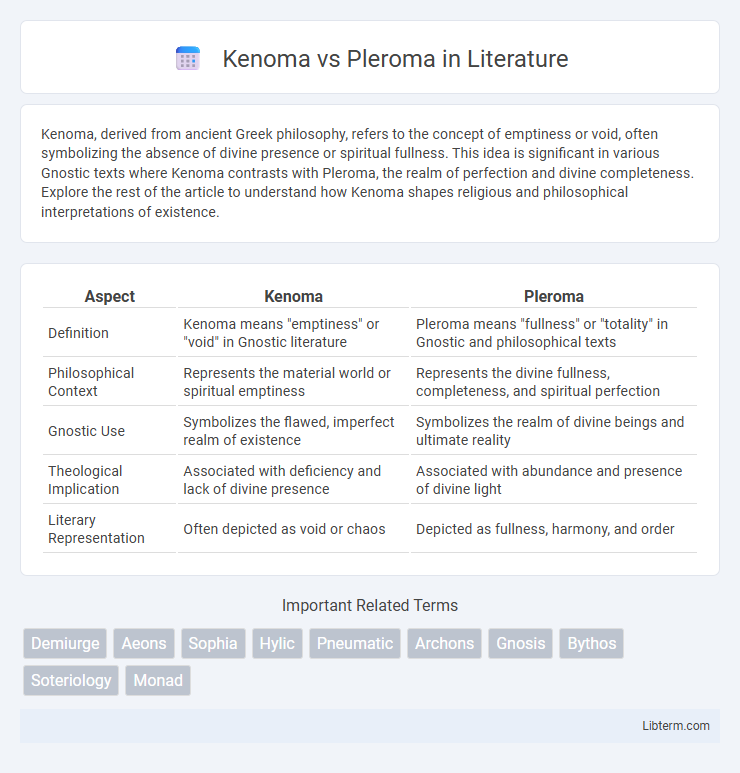Kenoma, derived from ancient Greek philosophy, refers to the concept of emptiness or void, often symbolizing the absence of divine presence or spiritual fullness. This idea is significant in various Gnostic texts where Kenoma contrasts with Pleroma, the realm of perfection and divine completeness. Explore the rest of the article to understand how Kenoma shapes religious and philosophical interpretations of existence.
Table of Comparison
| Aspect | Kenoma | Pleroma |
|---|---|---|
| Definition | Kenoma means "emptiness" or "void" in Gnostic literature | Pleroma means "fullness" or "totality" in Gnostic and philosophical texts |
| Philosophical Context | Represents the material world or spiritual emptiness | Represents the divine fullness, completeness, and spiritual perfection |
| Gnostic Use | Symbolizes the flawed, imperfect realm of existence | Symbolizes the realm of divine beings and ultimate reality |
| Theological Implication | Associated with deficiency and lack of divine presence | Associated with abundance and presence of divine light |
| Literary Representation | Often depicted as void or chaos | Depicted as fullness, harmony, and order |
Introduction to Kenoma and Pleroma
Kenoma and Pleroma are key concepts in Gnostic cosmology representing contrasting realms of existence; Kenoma refers to the void or emptiness symbolizing material deficiency and spiritual exile, while Pleroma signifies fullness and divine pleromatic harmony embodying the totality of divine powers. Kenoma is often associated with the flawed physical world and ignorance, serving as a background for the soul's entrapment and struggle. In contrast, Pleroma represents the perfect spiritual fullness where ultimate truth and light reside, highlighting the Gnostic aspiration for transcendence and return to divine unity.
Historical Origins of Kenoma and Pleroma
Kenoma and Pleroma originate from Gnostic cosmology, representing void and fullness respectively. Kenoma, derived from the Greek word for "void" or "emptiness," symbolizes the material world's imperfection and distance from divine light, while Pleroma, meaning "fullness," denotes the totality of divine powers and spiritual wholeness. These concepts emerged during early Christian Gnosticism as metaphysical terms describing the contrast between spiritual wholeness and material deficiency.
Gnostic Cosmology: Mapping the Divine and the Void
Kenoma and Pleroma represent fundamental concepts in Gnostic cosmology, delineating the contrast between the divine fullness and the void of deficiency. Pleroma signifies the totality of divine powers and the realm of light where emanations of the true God reside, embodying spiritual perfection and unity. In contrast, Kenoma denotes the emptiness or material world marked by chaos and imperfection, reflecting the flawed creation shaped by the demiurge separate from the divine fullness.
Kenoma: The Realm of Emptiness
Kenoma, often described as the Realm of Emptiness, represents a spiritual void or deficiency contrasted with the fullness found in Pleroma, the divine realm of plentitude. In Gnostic cosmology, Kenoma symbolizes a fractured state of existence where material and spiritual separation prevail, highlighting the human condition of alienation from divine wholeness. This concept emphasizes the quest for restoration and reunification with the Pleroma to transcend emptiness and attain true spiritual fulfillment.
Pleroma: The Realm of Fullness
Pleroma, derived from ancient Greek meaning "fullness," represents the spiritual realm of divine completeness and totality in Gnostic cosmology, contrasting sharply with Kenoma, the void or emptiness of the material world. It signifies a state of perfect harmony where divine light and knowledge reside, embodying the true essence of spiritual reality beyond physical existence. In Gnostic thought, achieving reunion with Pleroma is the ultimate goal, symbolizing liberation from ignorance and the material realm's incompleteness found in Kenoma.
Symbolic Interpretations in Gnostic Texts
Kenoma in Gnostic texts represents the realm of emptiness or deficiency, symbolizing the material world's imperfection and separation from the divine fullness. Pleroma embodies the totality of divine powers and spiritual fullness, signifying completeness and the ideal spiritual realm. These contrasting symbols highlight the Gnostic dualism between the flawed physical world (Kenoma) and the transcendent spiritual reality (Pleroma).
Kenoma vs Pleroma: Theological Contrasts
Kenoma and Pleroma represent contrasting theological concepts within Gnostic belief systems, where Kenoma signifies the realm of emptiness, deficiency, and material chaos, while Pleroma embodies fullness, divine light, and spiritual completeness. Kenoma is often depicted as the imperfect world created by lesser divine beings or demiurges, highlighting ignorance and separation from the true God, whereas Pleroma symbolizes the perfect, transcendent fullness of divine emanations and ultimate reality. This dichotomy underscores the Gnostic view of salvation as the soul's journey from the void of Kenoma back into the unified divine plenitude of Pleroma.
Psychological and Spiritual Implications
Kenoma represents spiritual emptiness and psychological void, often associated with feelings of alienation and existential despair in Gnostic thought. Pleroma symbolizes spiritual fullness and psychological wholeness, embodying a state of divine completeness and inner harmony. Understanding Kenoma and Pleroma provides insight into the human struggle between fragmentation and integration on both mental and spiritual levels.
Influence on Modern Philosophy and Spirituality
Kenoma and Pleroma represent contrasting metaphysical realms in Gnostic thought, influencing modern philosophy and spirituality by framing debates on the nature of existence and divine fullness. Kenoma, symbolizing emptiness or deficiency, challenges materialist and existentialist views by introducing a spiritual void that demands transcendence. Pleroma, as the fullness of divine light and knowledge, inspires contemporary mystical and holistic spiritual practices emphasizing unity, enlightenment, and inner completeness.
Conclusion: Reconciling Emptiness and Fullness
Kenoma and Pleroma represent contrasting metaphysical concepts, with Kenoma symbolizing emptiness or deficiency and Pleroma embodying fullness and divine completeness. Their reconciliation lies in understanding the dynamic interplay where Kenoma's lack prompts the movement toward Pleroma's totality, emphasizing a process rather than static states. This synthesis reflects a profound philosophical insight into existence, where emptiness and fullness coexist as complementary realities driving cosmic and spiritual development.
Kenoma Infographic

 libterm.com
libterm.com